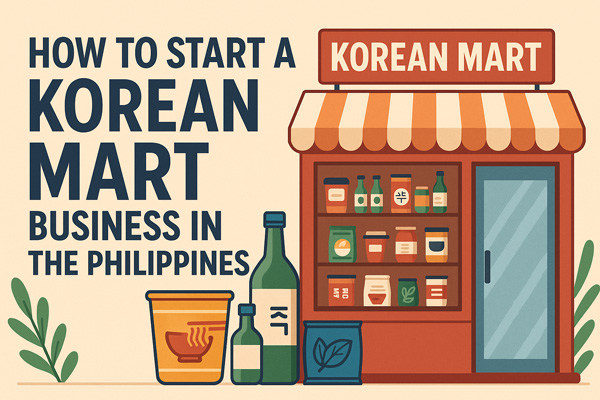Why a Korean Mart is a Smart Business Right Now
Korean food and culture have taken over Filipino hearts—from K-dramas to K-pop, and especially Korean snacks, noodles, and beauty products. With the rise of Korean grocery demand in local barangays, opening a Korean Mart can be both exciting and profitable. Filipinos are now looking for a one-stop shop for all things Korean, and with the right setup, you can be the first in your area to meet that demand.
Finding the Right Location: Foot Traffic is King
Before jumping into supplier deals, scout for a location where people actually walk by and shop. Korean Marts thrive in places with high foot traffic: near schools, condominiums, offices, and inside or beside wet markets. You don’t need a huge space—a well-organized 15–20 square meter store can be enough to get started. If a physical location is too expensive, you can start online or with a home-based setup using Facebook and Shopee.
Capital Needed and What It Covers
Starting a small Korean Mart can cost around P150,000–P300,000, depending on size and inventory. Most of your capital will go to the first batch of stocks (P80,000–P150,000), followed by equipment like freezers, shelves, signage, and minimal renovations. Don’t forget to set aside a portion for business permits, packaging, and a basic POS system. If you want to go even smaller, consider reselling curated Korean food bundles online first and reinvest your earnings.
Sourcing Your Korean Products: Local and Imported Options
There are two ways to stock your store: importing directly from Korea or sourcing from local Korean food distributors. Direct importing requires more paperwork, FDA registration, and bulk purchases, which may not be practical at the beginning. Instead, start by reaching out to local suppliers in Metro Manila like Assi Fresh Plaza, Korean Grocery Mart PH, and Koren Mart Wholesale. Some offer delivery to provinces and wholesale pricing even on small orders.
What to Sell: Bestsellers That Pinoy Shoppers Love
If you’re just starting, focus on the top-selling products that are already familiar to Filipinos. Korean instant noodles (especially Samyang and Jin Ramen), seaweed snacks, frozen mandu (dumplings), Korean BBQ meats, kimchi, soju, Korean ice cream, and beauty products like face masks and serums sell fast. You can also add a few cookware items like metal chopsticks, hotpot sets, and grill plates for added income.
Legal Requirements and Business Permits
Just like any small retail business, you’ll need to register with DTI (if sole proprietorship), BIR, and your local barangay and city hall. If you plan to import directly, you must register with the Bureau of Customs and apply for FDA approval for food items. But if you’re sourcing from local distributors, they already handle the compliance part, making your paperwork simpler.
Marketing Your Korean Mart on a Budget
Social media will be your best friend. Open a Facebook Page and post real photos of your products, promos, and deliveries. You can join local community groups to promote your store, especially if you offer delivery via GCash and same-day options. Offer discounts or freebies for first-time customers and display TikTok-style videos of Korean snacks being unboxed or eaten—these go viral fast.
Offer Korean Snack Bundles and Kits
One way to stand out is by creating Korean food kits or bundles. Examples include “K-Drama Night Kit” with instant ramen, seaweed, soju, and choco pies. You can also offer Samgyupsal BBQ sets for home use, complete with meat, lettuce, ssamjang, and kimchi. Bundles are easier to sell online and appeal to people who don’t know what to buy.
Add Value Through Experience, Not Just Products
To succeed long-term, think beyond selling goods. You can hold occasional tasting events, create content like “How to Cook Korean Ramyeon the Right Way,” or partner with K-pop fan groups. The more your store becomes part of the Korean wave experience, the more loyal customers you’ll attract. You’re not just selling snacks—you’re giving people a taste of Seoul in your own community.
Final Thoughts: Ride the Hallyu Wave While It’s Hot
The Korean Mart business isn’t just a trend—it’s a movement fueled by Filipino curiosity, social media, and pop culture. With low to moderate capital, flexible setup options, and a clear demand, it’s one of the most exciting small businesses to start today. If you’re ready to take the leap, start small, think smart, and grow with the rhythm of your customers.
Kamsahamnida and good luck on your Korean Mart journey!




